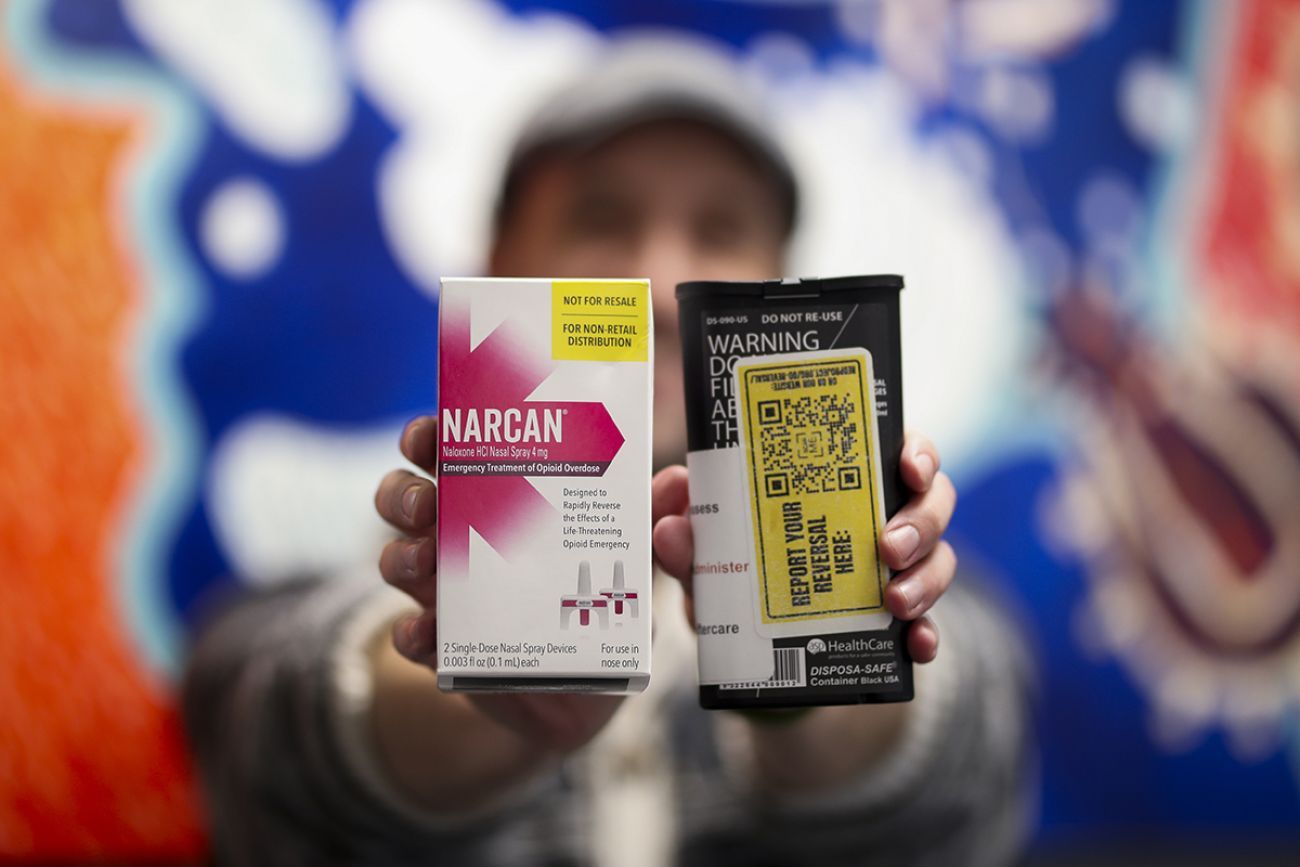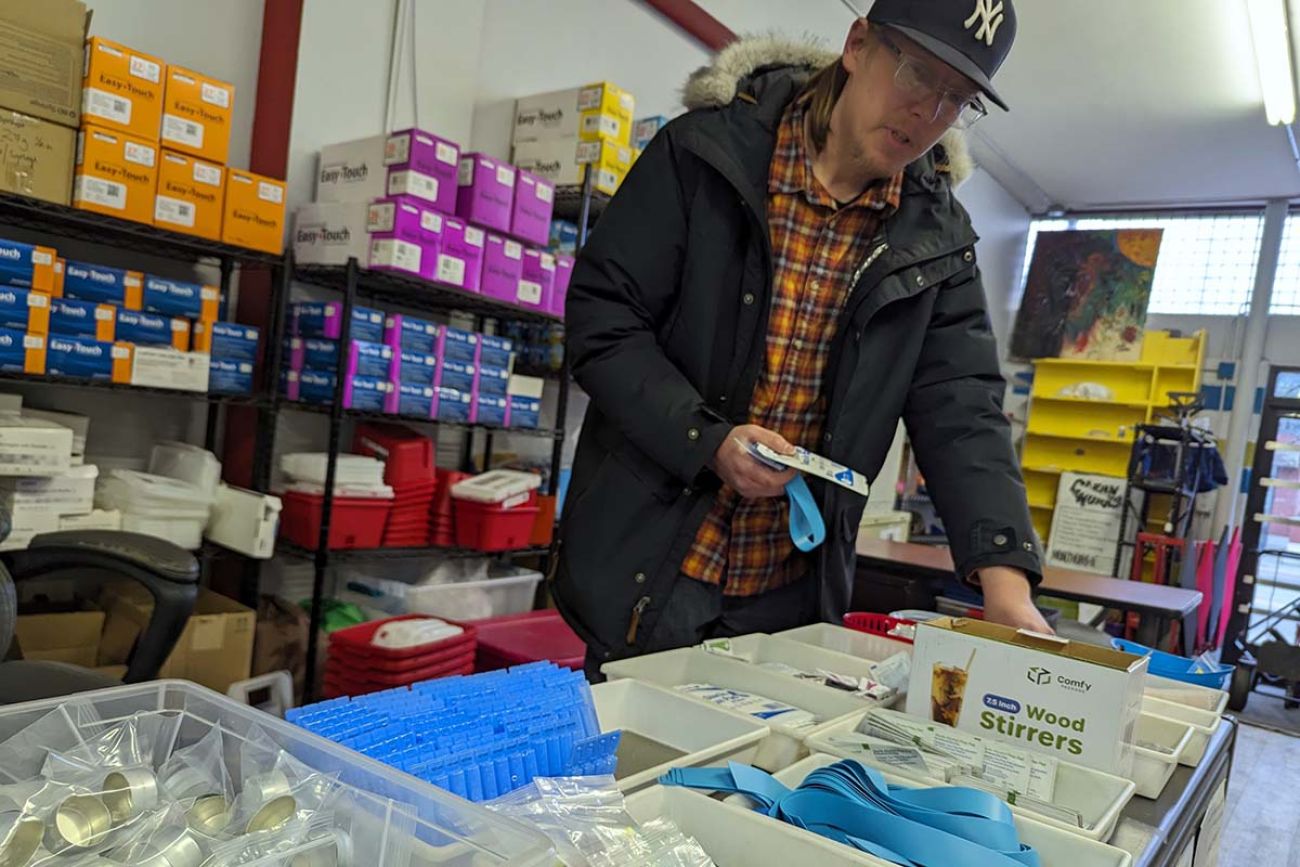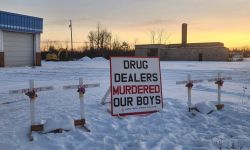As opioid funds flood Michigan, tensions rise over how best to reverse ODs

- As Michigan’s drug supply grows more potent, some argue overdose-reversal drugs need to increase in power, too
- Research shows that Narcan — first approved in 1971 as an injection to reverse overdoses — has been effective and cheap
- A new bill would enable access to more options, but some worry those alternatives are dangerous
As the street-drug supply in Michigan grows more potent, a proposed state law could open access to treatments that some argue are more powerful than traditional Narcan in saving lives.
But others say such naloxone — the drug known by the brand name option, Narcan, and available to the public for free — works just fine and is backed by years of research. Efforts to replace it, some advocates say, are little more than a money grab by pharmaceutical companies as government leaders decide how to spend millions of dollars in opioid settlement funds.
In 2022, more than 197,000 two-dose Narcan kits were ordered through Michigan’s naloxone portal, with the 4-mg dose costing the state $47.50. In contrast, Kloxxado — a naloxone product that is distributed in 8-mg doses — retails for about $141, according to Chelsea Wuth, spokesperson for the Michigan Department of Health and Human Services.
Related:
- Michigan opioid settlement dollars sit unspent as crisis rages
- Fighting Michigan's opioid crisis with new needles, purer drugs, respect for addicts
- Opinion | Michigan needs more options to combat opioid overdoses amid rise in fentanyl
Opvee, a second alternative to Narcan, retails for $113 for a supply of two sprays, according to two drug pricing websites, although it may be offered to governments at a discount.
Alternatives to traditionally dosed naloxone are “appealing, especially because there's so much conversation about how strong fentanyl is,” said Jonathan Stoltman, director of the Michigan-based Opioid Policy Institute, which tracks opioid settlement dollars.
He accused drugmakers of marketing “fear” by promoting the alternatives.
“Naloxone works fine,” he said.
“The instinct to overmedicate is how we got into this crisis. It's not going to get us out of it,” he added.
Now, a state senate bill introduced by Kevin Hertel (D-St. Clair Shores) would allow government entities and others to obtain overdose reversal drugs other than Narcan through a state-operated portal that launched in 2020.
The state health department takes no position on the proposed bill, Wuth said.
Such spending decisions are especially crucial now, as overdose deaths continue to climb nationally and community leaders around Michigan lay out spending plans for millions in national opioid settlement dollars.
The wrong choice could cost lives.
The state’s portal
To understand the need for reversal drugs is to first understand how opioids work. At low doses, they offer a sedative effect, making a user feel sleepy, for example. But higher doses can slow breathing and heart rate, causing death.
Naloxone and other reversal drugs attach to the opioid receptors, stopping those effects and triggering the person’s breathing again.
As it stands now, naloxone — first approved in 1971 as an injection and now available in a nasal spray — is free to anyone without prescription through the state portal. The portal is funded by the U.S. Substance Abuse and Mental Health Services Administration and operates in partnership with the drugmaker Emergent, which produces Narcan, the most common naloxone product.
Since its inception, the portal has distributed more than 860,000 two-dose kits across Michigan, according to Wuth, the health department spokesperson.
The argument for Narcan
Research has long shown that naloxone is effective in reversing overdoses. A 2018 study in the Addictive Behaviors journal found a 14% drop in deaths in states that enacted laws making it easier for the general public to access naloxone and “Good Samaritan laws, which protect people who report overdoses from being arrested. (Michigan’s Good Samaritan law went into effect in 2017.)
And last fall, Dr. Natasha Bagdasarian, Michigan’s chief medical executive, credited Narcan with reversing more than 6,600 overdoses statewide.
In its first round of expenditures from national opioid settlement funds, the state health department set aside $8.5 million to harm-reduction efforts on two fronts: syringe exchange programs and operating the state’s Narcan portal.
Narcan has been shown “safe and effective,” despite increases in fentanyl in the drug supply, Wuth told Bridge Michigan by email this week.
She said the state health department has been asked by “sales reps and lobbyists” to provide other opioid antagonists, but an analysis of EMS reports from 2019 to 2023 showed that paramedics delivered an average of 2.7 mg of naloxone per patient — “indicating that higher doses of naloxone are not needed” outside of medical settings.
Traditional Narcan nasal spray delivers a 4-milligram dose of naloxone, but EMS crews may use injectable naloxone, which can be given in smaller doses. Kloxxado, which the U.S. Food and Drug Administration approved in 2021, delivers an 8-mg dose of naloxone in its spray.
On occasions that a higher dose is necessary another dose of Narcan provides the extra naloxone, Wuth noted.
She referred to findings last year by the New York State Department of Health — spotlighted in a February CDC report. In a review of 353 overdose reports, researchers found no significant difference in survival outcomes between the group who received 4-mg doses and 8-mg doses of naloxone.
Additionally, patients who received the higher-dose naloxone were more than two-and-a-half times more likely to experience opioid withdrawal symptoms than those who received the conventional, lower dose.
Likewise, Opvee also has “no evidence” to justify its addition to the portal — Wuth said. The American College of Medical Toxicology and American Academy of Clinical Toxicology, in a joint statement, also noted a lack of evidence. The Michigan-based Families Against Narcotics also has issued a statement discouraging the use of anything other than naloxone.
That group, as well as Steve Alsum, executive director of Grand Rapids-based Red Project, a longtime harm-reduction nonprofit, said the drugs cause lingering and acute withdrawal symptoms.

Withdrawal is “almost a fight-or-flight type of thing,” he said.
That in turn, leads to a greater likelihood of a second — and this time, lethal — overdose as the person with substance use disorder seeks out more drugs to relieve nausea, vomiting, diarrhea, shaking, hot and cold flushes and the heightened panic that sets in alongside them.
There’s a cost to consider as well.
The argument for alternatives
Still, the state health department would not stand in the way of anyone who wants to purchase the alternatives, the health department’s Wuth noted.
Supporters of the bill to expand options say they’re not trying to push Narcan to the side, but simply offer more options as fentanyl and other additives increase the risks of Michigan’s drug supply.
Fentanyl, which increasingly has been cut into illicit drugs, can be up to 50 times stronger than heroin and 100 times stronger than morphine, according to the U.S. Centers for Disease Control and Prevention. Fentanyl was implicated in 1,505 Michigan deaths in 2018; in the first six months of last year, it had been implicated already in 1,062 deaths.
“Our request is just don't block access to other communities who want to have access to the higher dose” antagonists, said addiction researcher Dr. Desiree Crevecoeur-MacPhail, of Velocity BioGroup, a lobbying group working to establish Kloxxado as a go-to alternative to Narcan throughout the nation.
Kloxxado is essentially a double-dose of what is available to most of the general public in a two-pack of Narcan which offers two doses at four milligrams each.
It works faster by reaching the brain more quickly, Crevecoeur-MacPhail said. In oxygen deprivation, seconds count.

Greg Swan’s son, Drew, died in 2013 of an overdose of synthetic opioids, and the Bloomfield Hills man helped found Fentanyl Fathers, which speaks to high school students about fentanyl and how to reverse overdoses. Kloxxado has helped in those efforts, he said, with in-kind donations of their product. And London-based Hikma, which makes Kloxxado, has given the group a $10,000 grant for travel-related expenses in the efforts, he said.
But that’s not the reason he’s advocating for the naloxone alternative, Swan said.
“It comes down to one simple thing: If I find my other son unresponsive (in an overdose) and I have the options of 4 milligrams or 8 milligrams of naloxone, it’s a no-brainer which one I reach for,” he said.
Another alternative is nalmefene, known by the brand name Opvee and made by Virginia-based Indivior, which gained FDA approval last year.
Nalmefene works similarly to naloxone in that it blocks opioid receptors in the brain, jumpstarting respiration for a person who has overdosed. For now, it’s available by prescription only.
Opvee began shipping last year, months after FDA approval and with an endorsement by the former U.S. Surgeon General Dr. Jerome Adams.
In Southeast Michigan, Oakland County has been reported as the first in the nation to purchase Opvee on large scale. Of 100 doses, 73 have been used — all successful in restarting a person’s breathing, said Steve Norris, director of harm reduction and recovery support for the Troy-based Alliance of Coalitions for Healthy Communities.
“We have a good reversal medication out there that is a gold standard, has great data and all the things,” Norris said, referring to naloxone, “but I don't want that to get in the way of great.”
For his part, Oakland County Sheriff Mike Bouchard said Opvee is the next leg in a race against increasingly potent drugs and an unrelenting addiction crisis.
His department set up efforts to collect unused pills more than a decade ago, and the sheriff said he pushed for state law changes that enabled law enforcement to carry naloxone.
He said Opvee, which the department began to use with much fanfare, is an easy consideration: “In a lot of these cases, we're hitting somebody with Narcan one, two, three, even four times and it wouldn’t bring them back,” he said.
Opvee works fast, not only saving lives, but reducing the damage caused by every second that passes without oxygen to the brain, he said.
The drugmaker said a 2.7-mg nalmefene dose acted more rapidly than a 4-mg dose of naloxone in restoring regular breathing among 69 volunteers who were given either nalmefene, naloxone or both, in a clinical setting to compare the drugs.
It took naloxone 20 minutes to get the same result that nalmefene obtained in about five minutes, according to the drugmaker.
In Oakland County, body cam footage of one overdose reversal provided to Bridge shows an Oakland County deputy as she runs into a Dollar Store, where a woman has collapsed — not breathing — next to a shelf of charcoal and lighters.
The deputy drops to her knees, administering a dose of Opvee, then immediately begins chest compressions.
Other deputies arrive to help. Compressions continue. The woman on the floor remains still. Seconds tick by.
As the two-minute mark nears, the woman on the floor begins breathing on her own.
The deputy stops compressions and leans back: “She’s breathing — that “shit’s crazy,” she says, adding later to another deputy “That first dose got her back to life, got her back to breathing.”
Ultimately, that’s what matters most — offering a person that second chance at life, Bouchard told Bridge.
“If we can't stop them from dying when they’re laying in the ground in the street or wherever it may be — well, I’d be willing to take any heat to save a life.”
See what new members are saying about why they donated to Bridge Michigan:
- “In order for this information to be accurate and unbiased it must be underwritten by its readers, not by special interests.” - Larry S.
- “Not many other media sources report on the topics Bridge does.” - Susan B.
- “Your journalism is outstanding and rare these days.” - Mark S.
If you want to ensure the future of nonpartisan, nonprofit Michigan journalism, please become a member today. You, too, will be asked why you donated and maybe we'll feature your quote next time!








